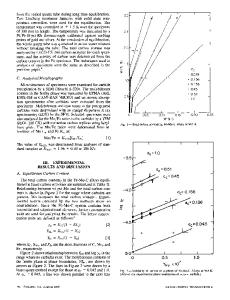Thermodynamics of surfaces and adsorption in the Fe-O and Fe-O-N systems at 1823 K
- PDF / 151,365 Bytes
- 5 Pages / 612 x 792 pts (letter) Page_size
- 92 Downloads / 287 Views
I. INTRODUCTION
SEVERAL researchers[1–5] have studied the kinetics of the nitrogen absorption or desorption in liquid iron in the presence of surface active elements such as sulfur and oxygen. So far, most of the studies have concentrated mainly on the kinetics of nitrogen absorption and desorption in molten iron and its alloys. Studies conducted on iron alloys containing small amounts of surface active elements such as oxygen and sulfur indicate that these elements, even at very low levels, remarkably retard the transfer of nitrogen through the interface into the bulk of these systems. Since the surface active elements lower the surface tension of liquid iron, they are preferentially adsorbed on the surface in accordance with the Gibbs adsorption isotherm. The adsorbed surface atoms are considered to influence the transfer of nitrogen across the gas-metal interface. The surface active elements such as oxygen and sulfur get adsorbed in the surface phase with the consequent decrease of the surface tension of the bulk metal. This blocking effect in the gasmetal interface is actually responsible for the dissolution of nitrogen from the gas phase to the metal phase (bulk). This, in turn, decreases the nitrogen content of the melt. Hooijmans and Ouden[6] have observed an enhanced absorption of nitrogen with an increase in the oxygen content in molten iron during arc melting of iron. They suggested that the surface active nature of oxygen hampers the desorption of nitrogen through the interface and that, as a result, the concentration of nitrogen is high in the bulk of the alloy. Studies of the surface tension of liquid iron containing surface active elements and nitrogen are rare. Analysis pertaining to the interaction of the various solutes in these systems has not so far been reported in the literature. In the present investigation, the surface tension and adsorption functions in the Fe-O and Fe-O-N systems are evaluated at 1823 K based on the Butler’s equations.[7] Interaction between oxygen and nitrogen is well known in bulk liquid iron but is not clearly understood in the surface phase.
D. MANTHA, Postdoctoral Research Fellow, is with the Department of Metallurgical and Materials Engineering, The University of Alabama, Tuscaloosa, AL 35487-0202. J.P. HAJRA, Professor, is with the Department of Metallurgy, Indian Institute of Science, Bangalore-560 012, India. Manuscript submitted July 7, 2000. METALLURGICAL AND MATERIALS TRANSACTIONS B
Recently,[8] we proposed the concept of surface interaction parameters in order to understand the energetics of the surface in these systems. The Butler’s equations, in conjunction with the derived values of the surface interaction parameters, as shown in Section II of the article, are useful in evaluating the adsorption behavior of nitrogen relative to oxygen in the system. II. APPLICATION OF THE BUTLER’S EQUATIONS IN THE SYSTEMS Using the infinitely dilute solution as standard state based on the Henrian law, the Butler’s equations as described in our earlier article[8] are express
Data Loading...











